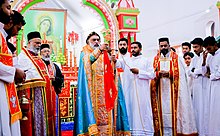Eucharist - Simple English Wikipedia, the free encyclopedia


The Eucharist, also called Holy Communion, the sacrament, or the Lord's supper, is a religious ritual in many Christian churches. It is especially important to Catholics, who believe it is necessary for salvation.
Biblical basis
[change | change source]According to the Bible, the Eucharist began at the Last Supper, when Jesus Christ told his followers that he was about to be killed. He told them to eat bread and drink wine in his memory. He explained that by doing so, they were eating the Body and Blood of Christ.
In John 6:54 Jesus says:
Whoever feeds on my flesh and drinks my blood has eternal life, and I will raise him up on the last day.
To Catholics (and some others), this means participating in Holy Communion is important for salvation.
In the Roman Catholic Church
[change | change source]Beliefs
[change | change source]According to the Roman Catholic Church, the Eucharist is the true presence of Jesus Christ, the son of God. Catholics believe that during a Mass, the bread and wine change into the Body and Blood of Christ (even though they do not change appearance). This process is called transubstantiation, and it is very important to Catholic beliefs.
Catholics in good standing (without unconfessed mortal sins) are supposed to receive and consume Christ during Holy Communion. During this process they are in the real presence of Jesus, according to Catholic belief. This is very different from Protestant beliefs, which say the Communion ritual is meant to be symbolic.
Early writings
[change | change source]In the 1st century, St. Ignatius of Antioch (a student of John the Baptist) wrote:
"[T]he heretics plaguing the church ... [do not take] the Eucharist because they do not confess that the Eucharist is the flesh of our Savior Jesus Christ" (Smyrnaeans, 7).

In the 2nd century, St. Justin Martyr wrote:
This food we call Eucharist, which no one is allowed to share except the one who believes that our teaching is true, and who has been washed with the washing that is for the remission of sins, and unto regeneration, and so lives as Christ has handed down. For we do not receive these as common bread and common drink; but just as Jesus Christ our Savior, having been made flesh by the word of God, had both flesh and blood for our salvation, so likewise we have learned that the food over which thanks has been given by the prayer of the word which comes from him, and by which our blood and flesh are nourished through a change, is the Flesh and Blood of the same incarnate Jesus (The First Apology).
In other churches
[change | change source]
Protestant churches
[change | change source]In most Protestant churches, the sacrament of communion involves eating small wafers or Matzos and drinking wine or grape juice. Most Protestants do not believe they are consuming the actual body and blood of Jesus. Rather, they think of communion as a very important - but symbolic - observance. They believe they are doing what Christ commanded.
Some Protestant churches offer communion daily, some weekly, some monthly, and some a few times a year.
Lutheranism
[change | change source]Like Catholics do, Lutherans teach that the bread and wine is Jesus' physical, true body and blood.[1][2][3] However, they do not agree with the Catholic idea of transubstantiation. Instead, they believe the bread is joined with Christ's body and that the wine is joined with his blood.[4] This view is called sacramental union and is commonly confused with consubstantiation, which teaches that the bread and wine are "side by side" with Jesus' body and blood.[5][6]
Mormonism
[change | change source]In the Latter Day Saints or "Mormon" Church, followers eat small pieces of bread and drink water. They believe that this is a symbol of the body and blood of Jesus, and they call it the Sacrament. They also believe that it helps them to make the promises of baptism all over again.
Related pages
[change | change source]References
[change | change source]- ↑ Confident.Faith (2020-10-21). "Part VI | Book of Concord". thebookofconcord.org. Retrieved 2024-08-09.
- ↑ "Lord's Supper". WELS. Retrieved 2024-08-09.
- ↑ Pahl04/01/2019, Jon. "An Economic Reading of Luther on the Eucharist, or How a Sacramental Economics Made Matter Matter in New Ways". elca.org. Retrieved 2024-08-09.
{{cite web}}: CS1 maint: numeric names: authors list (link) - ↑ "Sacramental Union". Pastor Zach's Blog. Retrieved 2024-08-09.
- ↑ thegardensofboxwoodmanor; October 9, on; Said, 2013 at 11:29 Am (2013-09-09). "Some misrepresentation and confusion: Lutherans and Consubstantiation". Pastor Reeder's Blog. Retrieved 2024-08-09.
{{cite web}}: CS1 maint: numeric names: authors list (link) - ↑ Theological Seminary of the General Synod of the Evangelical Lutheran Church in the United States, Theological Seminary of the General Synod of the Evangelical Lutheran Church in the United States (1888). Lectures on the Augsburg Confession : on the Holman Foundation. University of Wisconsin - Madison. Philadelphia : Lutheran Publication Society.


 French
French Deutsch
Deutsch